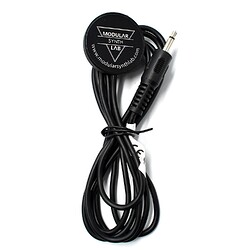Here is the system that I ended up using for analyzing sounds coming from my car. It was a smashing success, very affordable, and very DIY friendly. Much thanks to all that gave input.
Overview:
I used 3 contact microphones and 1 TM-10L lapel microphone attached to four cell phones via TRS-TRRS adapters. Recordings were made using the open-source Audio Recorder app by Dmytro Ponomarenko and perfectly synchronized using the classic clapperboard technique initiated along with a stopwatch. Editing and analysis was efficiently completed using Audacity (sorry Ardour).
Detailed Steps:
1. Power on all 4 cell phones
2. Check that they have sufficient battery level for the full test
3. Establish/Verify color coded pairing of contact mics and cell phones (ie by attaching different colored tape to each pair)
4. Mount contact mics onto target components
A. Clamps - its important that the microphone lead is firmly pressed against the component – a clamp is generally best for this type of constant pressing.
B. Use a combination of painter’s tape, zip ties, and velcro straps to secure the cables near the leads.
C. Make written notes of which colors are associated with which components
5. Open Audio Recorder app on all four devices (do not attach contact microphones yet)
6. Begin recording audio on all devices and place them near each other
7. Ring a chime as you simultaneously start a stopwatch
8. Connect phone/recorders to contact mics and test for proper recording function
A. Verify that phone-mic pairs are correctly color matched
9. Mount phones securely
10. Mount lapel mic/phone/stopwatch in cabin of vehicle
A. Attach lapel mic to your lapel
11. Begin testing
A. When a target noise is heard verbally notate and create timestamp (lap time)
12. End testing once you have one or two good samples of the target noise
13. Transfer sound files from all four phones to a computer
A. This can accomplished by using USB cables, email, SMS, or other cloud based transfer system such as GoogleDrive, ProtonDrive, OneDrive, etc.
14. Import sound files into Audacity
15. Delete all track information prior to the chime
16. Use timestamps and verbal notations to locate noise samples
17. Analyze sample data
A. Trace the source of the noise by observing which track contains the loudest sample
18. Formulate conclusion or narrow hypothesis
Using this technique I was able to plainly see the causes of two different noises. In my first test I found that my ball joint was the source of a clunking sound. In my second test I found that my lower control arm bushings were the source of a squeak-moan-groan sound.
Detailed notes about system elements:
$20ea High Quality Piezo Contact Microphone, Piezo Transducer, 27mm, 120cm cable, mono jack 3.5mm by ModularSynthLab
TM-10L Lavalier microphone by Tascam. This microphone sells for $90 direct from Tascam. I think any decent lavalier would do just fine.
Cell phones: I used abandoned old phones laying around the house and got a couple more old cell phones on eBay with cracked screens for around $20 each.
TRS-TRRS adapters: $4 ea. I tried a few before I found this one. Some didn’t work at all. These were the cheapest and the best! Even though the contact mics actually have TS plugs, these adapters still worked for them and the lapel mic perfectly.
3.5mm TRS to TRRS Adater Cable, Microphone Adapter Cable Cord, TRS Male to TRRS Female Adapter, by Riqiorod
Overall cost: $100-$150
